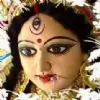Originally posted by: Urmila11
Friends, today is Kali Puja in Bengal 😊 & Debi didi is unavailable on IF right now, so I am posting this day's specialty on behalf of her.
Goddess Kalika: The Mother of universe
Kali is the Hindu goddess associated with eternal energy. "She who destroys". The name Kali comes from kala, which means black, time, death, lord of death, Shiva. Kali means "the black one". Since Shiva is called Kala - the eternal time, Kali, his consort, also means "Time" or "Death" (as in time has come). Hence, Kali is considered the goddess of time and change. Although sometimes presented as dark and violent, her earliest incarnation as a figure of annihilation still has some influence. Various Shakta Hindu cosmologies, as well as Shakta Tantricbeliefs, worship her as the ultimate reality or Brahman. She is also revered asBhavatarini (literally "redeemer of the universe"). Comparatively recent devotional movements largely conceive Kali as a benevolent mother goddess. Kali is represented as the consort of Lord Shiva, on whose body she is often seen standing. She is associated with many other Hindu goddesses like Durga,Bhadrakali, Sati, Rudrani, Parvati and Chamunda. She is the foremost among the Dasa Mahavidyas, ten fierce Tantric goddesses.
Etymology
Kali is the feminine form of kala ("black, dark coloured"). Kala primarily means "black" but also means "time." Kali means "the black one" and also "time" or "beyond time." Kali is strongly associated with Shiva, and Shaivas derive her feminine name from the masculine Kala (an epithet of Shiva). A nineteenth-century Sanskrit dictionary, the Shabdakalpadrum, states: ???? ???? ? ???? ??????? - ???? ? kala? siva? ? tasya patniti kali - "Shiva is Kala, thus, his wife is Kali."
Other names include Kalaratri ("black night"), as described above, and Kalika("relating to time"). Coburn notes that the name Kali can be used as a proper name, or as a description of color.
Kali's association with black stands in contrast to her consort, Shiva, whose body is covered by the white ashes of the cremation ground (Sanskrit: smasana) in which he meditates, and with which Kali is also associated, as smasana-kali.
Kali is frequently confused with the word kali, as in Kali Yuga or the demon Kali. However, the words Kali ("black, time") and kali ("weak, crude, inarticulate") are etymologically unrelated, and the goddess Kali is not associated with Kali Yuga.
Origins
Hugh Urban notes that although the word Kali appears as early as the Atharva Veda, the first use of it as a proper name is in the Kathaka Grhya Sutra (19.7). Kali is the name of one of the seven tongues of Agni, the [Rigvedic] God of Fire, in theMundaka Upanishad (2:4), but it is unlikely that this refers to the goddess. The first appearance of Kali in her present form is in the Sauptika Parvan of theMahabharata (10.8.64). She is called Kalaratri (literally, "black night") and appears to the Pandava soldiers in dreams, until finally she appears amidst the fighting during an attack by Drona's son Ashwatthama. She most famously appears in the sixth century Devi Mahatmyam as one of the shaktis of Mahadevi, and defeats the demon Raktabija ("Bloodseed"). The tenth-century Kalika Purana venerates Kali as the ultimate reality or Brahman.
According to David Kinsley, Kali is first mentioned in Hinduism as a distinct goddess around 600 CE, and these texts "usually place her on the periphery of Hindu society or on the battlefield." She is often regarded as the Shakti of Shiva, and is closely associated with him in various Puranas. The Kalika Purana depicts her as the "Adi Shakti" (Fundamental Power) and "Para Prakriti" or beyond nature.
In Tantra

Kali Yantra
Goddesses play an important role in the study and practice of Tantra Yoga, and are affirmed to be as central to discerning the nature of reality as are the male deities. Although Parvati is often said to be the recipient and student of Shiva's wisdom in the form of Tantras, it is Kali who seems to dominate much of the Tantric iconography, texts, and rituals. In many sources Kali is praised as the highest reality or greatest of all deities. The Nirvana-tantra says the gods Brahma,Vishnu, and Shiva all arise from her like bubbles in the sea, ceaselessly arising and passing away, leaving their original source unchanged. The Niruttara-tantra and the Picchila-tantra declare all of Kali's mantras to be the greatest and the Yogini-tantra, Kamakhya-tantra and the Niruttara-tantra all proclaim Kali vidyas(manifestations of Mahadevi, or "divinity itself"). They declare her to be an essence of her own form (svarupa) of the Mahadevi.
In the Mahanirvana-tantra, Kali is one of the epithets for the primordial sakti, and in one passage Shiva praises her:
- At the dissolution of things, it is Kala [Time] Who will devour all, and by reason of this He is called Mahakala [an epithet of Lord Shiva], and since Thou devourest Mahakala Himself, it is Thou who art the Supreme Primordial Kalika. Because Thou devourest Kala, Thou art Kali, the original form of all things, and because Thou art the Origin of and devourest all things Thou art called the Adya [the Primordial One]. Re-assuming after Dissolution Thine own form, dark and formless, Thou alone remainest as One ineffable and inconceivable. Though having a form, yet art Thou formless; though Thyself without beginning, multiform by the power of Maya, Thou art the Beginning of all, Creatrix, Protectress, and Destructress that Thou art.
The figure of Kali conveys death, destruction, and the consuming aspects of reality. As such, she is also a "forbidden thing", or even death itself. In thePancatattva ritual, the sadhaka boldly seeks to confront Kali, and thereby assimilates and transforms her into a vehicle of salvation. This is clear in the work of the Karpuradi-stotra, a short praise to Kali describing the Pancatattvaritual unto her, performed on cremation grounds. (Samahana-sadhana)
- He, O Mahakali who in the cremation-ground, naked, and with dishevelled hair, intently meditates upon Thee and recites Thy mantra, and with each recitation makes offering to Thee of a thousand Akanda flowers with seed, becomes without any effort a Lord of the earth. 0h Kali, whoever on Tuesday at midnight, having uttered Thy mantra, makes offering even but once with devotion to Thee of a hair of his Shakti [his energy/female companion] in the cremation-ground, becomes a great poet, a Lord of the earth, and ever goes mounted upon an elephant.
The Karpuradi-stotra clearly indicates that Kali is more than a terrible, vicious, slayer of demons who serves Durga or Shiva. Here, she is identified as the supreme mistress of the universe, associated with the five elements. In union with LordShiva, who is said to be her spouse, she creates and destroys worlds. Her appearance also takes a different turn, befitting her role as ruler of the world and object of meditation. In contrast to her terrible aspects, she takes on hints of a more benign dimension. She is described as young and beautiful, has a gentle smile, and makes gestures with her two right hands to dispel any fear and offer boons. The more positive features exposed offer the distillation of divine wrath into a goddess of salvation, who rids the sadhaka of fear. Here, Kali appears as a symbol of triumph over death.
One of the most well respected author Dr. David Frawley, also known as Vamdeva Shastri, has explained the meaning of Beeja Mantra of Ma (Mother) Kali in a lucid manner. The mantra is "AUM AIM HREEM KLEEM CHAMUNDAYE VICHCHE SWAHA |" Usually this mantra is sung during Bali or animal slaughter. But it has a dominating knowledge aspect to it, which is now very well understood in various world literatures.
Aum ' Prayer; Aim ' Symbolic of knowledge by Goddess Saraswati; Hreem ' Symbolism of transformation; Kleem ' Symbolism of confidence or strength; Chamundaye Vichche ' Decapitation (Considered as fall of EGO) and Swaha ' Sacrifice or Yajna prayer.
This interpretation states that Goddess Kali through knowledge brings transformation in a devotee by excising the Ego, and then blesses the devotee with enormous strength and confidence.
So by this interpretation, animal slaughter is not required for prayering Goddess Kali as Dravya Yajna (material sacrifice). Prayers can be offered to Goddess Kali through Pure Knowledge or Gyan Yajna that is EGO sacrifice.
In Bengali tradition

Kali Puja festival
Kali is also a central figure in late medieval Bengali devotional literature, with such devotees as Ramprasad Sen (1718'75). With the exception of being associated with Parvati as Shiva's consort, Kali is rarely pictured in Hindu mythology and iconography as a motherly figure until Bengali devotions beginning in the early eighteenth century. Even in Bengali tradition her appearance and habits change little, if at all.
The Tantric approach to Kali is to display courage by confronting her on cremation grounds in the dead of night, despite her terrible appearance. In contrast, the Bengali devotee appropriates Kali's teachings adopting the attitude of a child, coming to love her unreservedly. In both cases, the goal of the devotee is to become reconciled with death and to learn acceptance of the way that things are. These themes are well addressed in Ramprasad's work.
Ramprasad comments in many of his other songs that Kali is indifferent to his wellbeing, causes him to suffer, brings his worldly desires to nothing and his worldly goods to ruin. He also states that she does not behave like a mother should and that she ignores his pleas:
- Can mercy be found in the heart of her who was born of the stone? [a reference to Kali as the daughter of Himalaya]
- Were she not merciless, would she kick the breast of her lord?
- Men call you merciful, but there is no trace of mercy in you, Mother.
- You have cut off the heads of the children of others, and these you wear as a garland around your neck.
- It matters not how much I call you "Mother, Mother." You hear me, but you will not listen.
To be a child of Kali, Ramprasad asserts, is to be denied of earthly delights and pleasures. Kali is said to refrain from giving that which is expected. To the devotee, it is perhaps her very refusal to do so that enables her devotees to reflect on dimensions of themselves and of reality that go beyond the material world.
A significant portion of Bengali devotional music features Kali as its central theme and is known as Shyama Sangeet ("Music of the Night"). Mostly sung by male vocalists, today even women have taken to this form of music. One of the finest singers of Shyama Sangeet isPannalal Bhattacharya.
In Bengal, Kali is venerated in the festival Kali Puja - the new moon day of Ashwin month which coincides with Diwali festival.
In a unique form of Kali worship, Shantipur worships Kali in the form of a hand painted image of the deity known as Poteshwari (meaning the deity drawn on a piece of cloth).














































